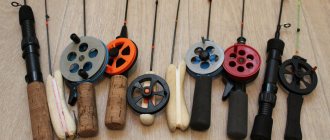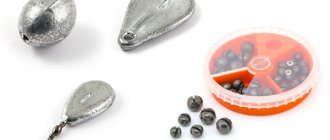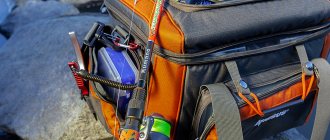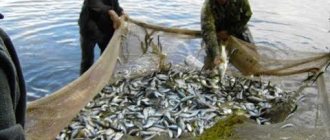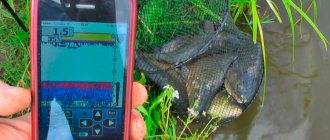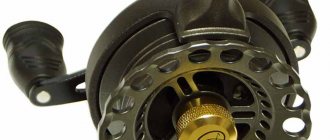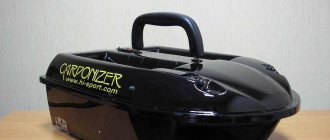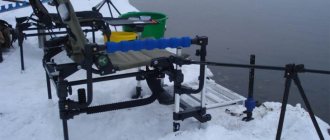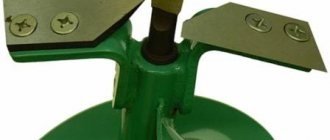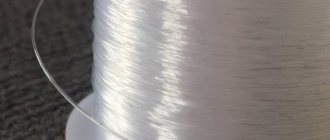How to choose a fish tank
If you want to purchase a cage for amateur fishing and make rare trips, you need to choose a cage that is easy to transport and store and has an affordable price.
At first glance, a metal cage may be the ideal solution. Since it is relatively cheap, it is practically indestructible and does not need to be dried.
But it has a number of disadvantages.
- The fish in it will not be able to remain alive for a long time.
- And because of its short length, you will have to constantly get up from your seat in order to place the fish.
Therefore, with constant biting, you will be faced with a large number of squats and bends.
For more comfortable fishing, you should pay attention to the cages used by sports fishermen. The peculiarity of which is their long length.
Almost every fishing product company can offer cages no longer than 3 m at a reasonable price.
If you take part in competitions, you definitely need a sports class cage. As already mentioned, sports cages are longer.
This was done to ensure that the caught fish remained alive throughout the competition. There are often cases when, when choosing a place, you come across a difficult topography of the coast or a steep descent to the water. And it is in such situations that a long cage will be simply necessary.
According to official international rules, the cage must be at least 4 m long. But for local amateur competitions, three-meter cages are quite suitable.
Making a cage with your own hands
Not all fishermen are satisfied with the cost and quality of the fishing cages sold. With some ingenuity, you can create your own fish storage tank yourself. It is not difficult to choose a mesh with a suitable length, width and cells on the market.
To create flexible rings, a metal cable in a polymer braid is perfect. The cable is passed through the mesh cells, forming a circle. The ring can be fastened by tying the ends of the cable with a nylon thread or by rolling them in a metal tube. How many such rings are needed depends on the length of the intended cage. This cage is easy to fold, it can be placed in a bag or a small case and it takes up very little space.
Having a fishing cage is very important for a fisherman if he needs fresher fish. The choice of fishing cage depends on the purpose of fishing and fishing methods. The main thing is to keep the fish alive as long as possible.
Author of the article: Vitaly Leonidovich Ivanov, 2021.
Round or square cage?
Once you have decided on the length of the cage, you need to choose a shape.
Lately, round cages have faded into the background. But still, they are ideal for fishing on a dam. Especially in strong winds that raise high waves.
A square cage will rub against the dam slabs, while a round one will simply roll, thereby avoiding subsequent abrasion.
In all other cases, you should be guided only by personal preferences. According to most anglers, square cages are more practical.
What is a garden for?
A cage is a device in which caught fish remains alive and undamaged for up to several days.
The cage is indispensable for fans of sport fishing, which has become popular in recent years for catch-and-release fishing. In this case, the caught fish must be at a sufficient depth and not be damaged in order to continue a full life.
A fisherman who prefers the traditional method of fishing is also interested in keeping the catch in clean water during the entire fishing trip.
What cage material should I choose?
The best option in almost all respects is a cage made of nylon thread coated with latex or rubber.
Since when catching any fish, the material of the cage will absorb its smell, if the cage is made of ordinary fiber or thread, it will retain an unpleasant odor for a long time.
Latex practically does not absorb odors. And another advantage is its ability to dry quickly. 5–10 minutes are enough for the cage to dry completely. And this will allow you to avoid buying a special bag for the fish tank.
As for the cage structure, the choice is between a large mesh and dense fabric. It all depends on what kind of trophies you are going to put in it.
The cage I chose
The cage that I chose and purchased before my upcoming fishing for large crucian carp can be called an average version of cages between a sporty type and the most amateurish one, which is almost a utility net-string bag. If sports cages can be up to four to five meters long and 40-50 cm in size with a square hoop, then in this case the cage has a length of 1.7 meters with a round hoop diameter of 33 centimeters, which is the norm for a cage of this type. Even a cage with a diameter of 30 cm can be called quite functional and optimal for fishing for any “white” fish. In addition, the relatively fine mesh of the cage is an advantage over the larger mesh cells of some sports cages, which carp and carp simply cut with their fin-files.
Tank for carp and large crucian carp
If it is carp or large crucian carp, then you should definitely take thick fabric. Because thanks to its dorsal fin, which fishermen call a “saw,” the fish can catch on a large mesh and thereby tear the cage.
In addition, if the fish tank is made of thick fabric, then you will immediately notice a hole. If it is bream, roach or other “white” fish, then material with a cell size of up to 0.5 cm is quite suitable. And an important factor is, again, that a fish tank with a large cell dries quickly.

Review of fishing cages
Sports fishing cages differ from amateur cages in several ways:
- They are made from modern nylon or polyester materials. They have rack mounts and their tilt can be adjusted.
- They are long (up to 5 meters).
- They have increased strength for a large number of fish.
- They are distinguished by a high price of 1000-5000 rubles.
- They have a fine-grained net to avoid injury to the fish.
Fish tank with or without rings
Particular attention should be paid to the cage rings. As a rule, they are located at a distance of 20–40 cm from each other and have the largest coefficient of contact with the bottom.
Therefore, it is necessary to choose rings that are located outside the cage and are made of metal. Typically aluminum. They will withstand aggressive bottoms for a long time and will withstand a huge number of fishing sessions on various dams.
Another important advantage is the ability to remove the cage from the water. Intercepting it precisely by the hard rings. This will be especially true if the catch is a couple of tens of kilograms.
You might be interested
In spring shallow water
Also, rigid rings will contribute to the even position of the cage in the water.
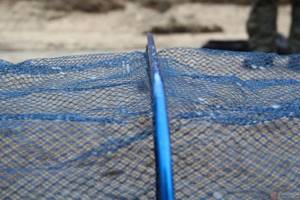
Selection of cage
Choosing a cage The most vulnerable place for cages is in the places where the mesh wraps around the rings.
This is where the mesh wears out most quickly. Moreover, during a good wave, and even on a rocky bottom, a branded fish tank can self-destruct even in one fishing trip. There is a problem with the longevity of fish tanks. To avoid headaches about this in the future, you can pay attention to models of cages in which the mesh along the rings is protected on top by an additional hoop. Or choose a simpler cage and upgrade it yourself using a similar method. This is done simply. Along the hoops, the mesh is additionally covered with a polyvinyl chloride hose cut in half, which is secured to the hoop with clamps.
One of the essential criteria for choosing a cage is the preservation of the smell of fish. In principle, the residual odor will be tolerable if fishing gear is stored somewhere far from home - in a barn, in a garage... with friends. But if you have to store the fish tank in an apartment, then serious odor problems arise.
A cage made of fishing line or rubberized thread retains the least residual odor. And the fish’s fins cling to the thick monofilament much less.
By the way, one of the ways to combat the smell of the cage is to eliminate this fight yourself, and take the cage to a car wash, where it will be washed with car cleaning products, which will almost completely remove the smell.
Also, when choosing a cage, you should pay attention to its compatibility with existing fishing equipment. If you still have a box, platform, stand, then you should consider how the cage will be attached to them, so that it would be as convenient to use as possible.
Fastening and adjusting the tilt of the cage
Each fishing company mounts and adjusts the tilt level at its own discretion.
There are mainly two types.
- The first is the button adjustment, which is very convenient and practical.
- The second method is a clamping washer.
Most often it is used by English manufacturers. According to many fishermen, this method is extremely impractical. Because you have to set a certain angle, and then screw the cage to the mount. And during the fishing process you will not be able to change the angle.
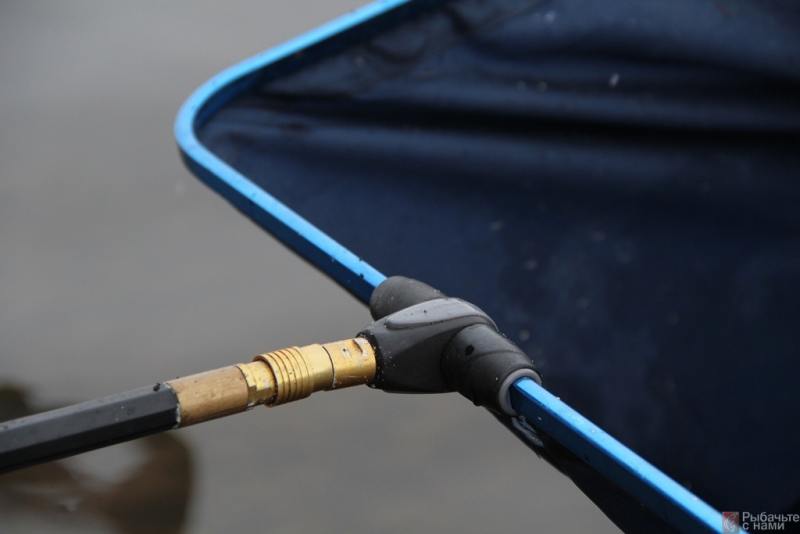
Varieties of cages by shape, material and size
Why do you need a cage?
A fishing cage is a special device for fishermen who expect to be at the fishing site for a fairly long period of time - from 5-6 hours or more. In this case, there is a problem with keeping the trophies fresh. This can be done using a refrigerator, but you will have to take care of the electricity for it.
The best option is to store fish in a cage. By its design, it is a product made of mesh with elements of rigidity, which is lowered into the reservoir before fishing begins. Trophies pulled out of the water are lowered into such a fish tank. They cannot swim away from the fisherman, but at the same time, the presence of running water provides them with normal conditions for existence. Fish can live in a cage for quite a long time if you choose a model of the appropriate size.
Types of fishing cages
In stores that sell fishing accessories, you can find hundreds of different models of cages. You need to choose based on the planned fishing conditions, the duration of the fishing, the size and type of fish that you plan to store in the cage.
When choosing, you need to pay attention to the following characteristics:
- Dimensions and shape of the device.
- Material for making the accessory.
- The size and number of frame rings and the distance between them.
- The size of the mesh cells that prevents fish from escaping.
Materials for making cages
Based on the material used, there are several types of cages:
- Metal. They are used when fishing is done from the side of a craft. The main advantage of such products is greater strength. The metal cage is not destroyed as a result of the impact of sharp fins or teeth of prey caught in it. In addition, it will not be chewed by otters or nutria while roosting. Metal does not absorb odor and is easily cleaned of dirt. And thanks to its long service life, you are unlikely to ever need to replace it with a new one. As disadvantages, it is necessary to highlight the possible trauma for fish (they can damage the scales and die) and the small capacity. In addition, when fishing in shallow water, such products are not very convenient to use.
- Nylon. These cages use a mesh of fishing line. Due to the versatility and lightness of the material, nylon cages are presented in larger quantities. It is more convenient to use, and the fish stays alive for a longer period of time. The only drawback is that nylon is abrasive, so the cage cannot be placed on concrete slabs or rocky bottoms.
Dimensions and structural elements
These parameters vary over a wide range. The minimum length of a fishing cage is 40 cm, the maximum can reach 5 meters. The most commonly used models are with a length of 2 to 3 meters. It is rare to find 5-meter products; they are more suitable for fishing from a steep bank, when the length is necessary to reach the surface of the water.
The shape of the cages can be round or rectangular. This parameter in no way affects the convenience and ergonomics of using the product. Round models are more common; the diameter of the ring in them is 35 cm, the distance between adjacent elements is 30 m. It is better to buy a rectangular one if you plan to fish in shallow water. It is easier to install on the bottom.
When choosing, it is also important to pay attention to the cell size. You should not use products with holes that are too small (up to 2 mm), as this will limit the access of fresh water and the fish will begin to suffocate. Models with a cell size of 8 mm are usually used. This is enough for normal breathing of fish, but at the same time, carp, carp and crucian carp cannot cut it with their fins.
Cage storage
Particular attention should be paid to storing the cage. Before storing it in the garage or utility room, you need to let it dry completely. And make sure that the family of rodents does not have access to the storage area.
Before each casting of the cage into the water, it is worth checking to see if there are any fittings or other objects at the bottom. Which can appear thanks to modern civilization even in places remote from urban settlements.
With careful use, even the most budget cage will last a long time.
Securing the fishing cage on the shore
A situation that often happens is that the fish tank floats and washes ashore. When fishing on a large wave, especially one created by boats, when opening locks on a canal, etc. If the cage “runs away” you have to fix it with a weight. In this case, it is better not to put stones inside the cage. Because, firstly, there may be gusts when pulling out and the escape of the catch, and secondly, the catch itself can once again be injured by a sharp stone. It is better to tie a rope or rubber with a weight to the end of the cage, and use such a device to fix the cage in one position. True, it is possible that the load may get stuck when pulling it out... Well, you’ll have to get it out. The second point is also related to the swimming of the cage, only this time in the opposite direction - from the fisherman to the middle of the reservoir. And this phenomenon is quite common. The reason lies in the unreliable fastening of the neck to the shore. Modern cages have a special threaded attachment to fishing posts, which in turn are securely attached to the platform or to the shore. If there is no such equipment, then you must use a wire tied in a knot to a stake driven into the ground.
Live bait tank - installation in a hole
Not all winter fishermen know how to properly preserve live bait in a reservoir while fishing, especially for several days. There are various ways to solve this problem.
First, about preserving live bait during fishing. In winter, many fishermen use summer can for transporting and preserving them. On a pond, it is sometimes buried in snow for thermal insulation, and the water is periodically changed to maintain a favorable oxygen regime. However, such labor-intensive operations do not always ensure the viability of live bait even during one daylight hours.
At the same time, there is a reliable way to preserve live bait in a reservoir. In this case, the container for storing them is made of a polyethylene bottle with a volume of 1.5-2.25 liters (depending on the diameter of the hole).
When making such a cage, you should pay attention to the following points. Firstly, the upper transverse cut of the bottle must be made at the level of the conical part so that the cut diameter is approximately 5-10 mm smaller than the size of the cylindrical part of the bottle. This is necessary so that there is a kind of limiter for the movement of the lifting plunger. In addition, it is more convenient to put on a cap made from the bottom of another similar bottle, cut at approximately 40-60mm from the bottom (Fig.).
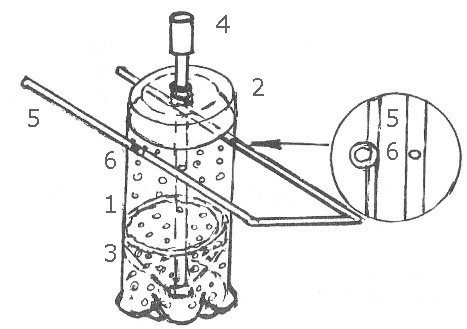
1 – capacity; 2 - cover; 3 — lift-plunger; 4 — axis of fastening of the lift-plunger; 5 — support for holding the cage when installed in the hole; In the circle there are varieties of supports made of flat rods and wires.
Secondly, holes for water exchange in the container body must be made from the inside (with wire or a nail heated over an open fire). This will avoid injury to live bait, because the torn edges of the punctures will face outward and will also not interfere with the free movement of the lifting plunger.
Internal punctures are carried out in two stages. Initially, according to the markings, punctures are made on the outside of the bottle using a thin heated wire or nail. Then, using a similar device, but of a larger diameter (if necessary, L-shaped), the container is pierced from the inside.
The next stage is the manufacture of a plunger lift. For the lower lifting part of this device, you can use the previously cut off upper part of the same bottle along with the cap. Several holes are made on the surface of the lift - the same as on the body. Their purpose is to reduce resistance when lifting the device in an aquatic environment.
A hole is made from the bottom of the plug screwed onto the neck of the lifting part and a screw is inserted, the size of which is selected in such a way that it can be used to install a vertical plastic or metal tube or rod. When used as the central part of a tube lifter, the screw can be screwed in or secured with adhesive and sealant. The rod and screw can be connected through an adapter coupling or a threaded connection.
This assembly should be placed inside the container. If the diameter of the lifter exceeds the size of the upper cut of the bottle, then it is necessary to compress it somewhat and forcefully insert it into the container. A cover with a pre-drilled hole of the appropriate size is installed on top of the central axis of the lift.
Having sunk the lifting plunger into the container until it stops and putting on the lid, a mark is made of its position on the central axis. Based on this mark, caps from plastic bottles are put on from the bottom and top of the lid through pre-drilled holes (with open parts facing each other), and their position is fixed with glue or horizontal pins through the side walls of the cork and the central axis. As a result of this fastening, the cover will be securely held during operation.
After this, the lift-plunger along with the lid is removed, and the rotary transverse clamps of the container are installed in the hole, which simultaneously serve as a handle. For fastening from the inside, you should choose screws with a thin flat head, and from the outside, they are put on in sequence: a washer, a rotary lock made of a flat piece of metal or thin wire, a washer, a nut. After adjusting the smoothness of the handle's rotation, the screw thread is cored to prevent the nut from unscrewing itself.
This cage can be used not only to preserve live bait in a reservoir, but also to transport them, for which it should be placed in a large container with water. This cage can also be used in the summer.
Now let’s look at a method for long-term preservation of live bait in a reservoir, which significantly increases the efficiency of fishing using both above-ice and under-ice poles. Sometimes winter fishermen try to preserve live bait for a long time by placing them in a hole in a soft fine-mesh net, while at the same time thermally insulating the hole with straw, a layer of snow, etc. But this method is not effective enough: often, live bait placed in cramped conditions quickly falls asleep or freezes into the ice due to insufficient thermal insulation.
However, long-term preservation of live bait in a reservoir is quite possible. To achieve this, you should select a 1-liter wide-neck bottle (for example, a kefir bottle) and make several small holes on its upper conical part for water exchange. If such holes are made over the entire surface, then when lifting the bottle from the hole, streams of water can fall on the fisherman’s clothes and shoes. In addition, the possibility of transportation will be excluded, because Live baits left without water will die.
Caught live bait is launched into a bottle, which is filled with water up to the water exchange holes, screwed on with a cork, tied with twine made of synthetic yarn, lowered into the hole and filled with water through the holes until flooding. If necessary, you can throw 2-3 coins, nuts, screws, etc. into the bottle for ballast. The end of the twine is fixed to the ice surface (for example, tied to a stick placed across the hole).
A polyethylene bottle with a narrow neck of larger capacity (1.5-2.25 l) can be used as such a cage. To plant live bait in such a bottle, use a knife to make a longitudinal cut in the conical part of its body, corresponding in length to approximately two transverse dimensions of the live bait. By squeezing one of the parts of this cut with your finger, the next caught live bait is launched into the resulting gap. In such a bottle, there is no need to make holes for water exchange, or they can only be pierced in the area of the cone part.
The location of the cage is marked accordingly. If it is necessary to remove the container to the surface, the same operations should be performed as when lifting an under-ice vent.
When using extracted live bait to “recharge” the girders, they should be transplanted into a cage designed for installation in a hole.
Depending on the frequency of fishing trips
If you want to purchase a cage for amateur fishing and make rare trips, you need to choose a cage that is easy to transport and store and has an affordable price. At first glance, a metal cage may be the ideal solution, since it is relatively cheap, practically indestructible and does not need to be dried.
But it has a number of disadvantages. The fish will not be able to stay alive in it for a long time, and due to its short length, you will have to constantly get up from your seat in order to place the fish. Therefore, with constant biting, you will be faced with a large number of squats and bends. For more comfortable fishing, you should pay attention to the cages used by sports fishermen, the peculiarity of which is their long length. Almost every fishing product company can offer cages no longer than 3 m at a reasonable price.
If you take part in competitions, you definitely need a sports class cage. As already mentioned, sports cages are longer. This was done to ensure that the caught fish remained alive throughout the competition.
There are often cases when, when choosing a place, you come across a difficult topography of the coast or a steep descent to the water, and it is in such situations that a long cage will be simply necessary. According to official international rules, the cage must be at least 4 m long. But for local amateur competitions, three-meter cages are quite suitable.
A fishing cage is a device in which the catch is stored. The caught fish is lowered into the cage and placed in the water. This allows you to save the caught fish and bring it home in fresh condition.
Types of fishing cages
When going to a lake or river, a fisherman rarely plans to spend an hour or two doing his favorite pastime. But caught fish left in an ordinary bucket will probably spoil over time. This is why experienced fishermen always use cages.
Before you buy a fishing cage
, you need to understand the varieties of such devices. There are cages:
- Metal - an inexpensive and very durable option, ideal for fishing from a boat. The main disadvantage of the device is that the fish is injured by metal and its lifespan is short;
- In the form of a mesh made of fishing line or artificial threads. Fish are best preserved in such cages; it is convenient to put your catch in them without even getting up from your seat;
- Sports - consisting of rectangular or round sections connected by mesh fabric. This species can be placed on any part of the shore; the fish in the cage will always be comfortable. But this device requires care: after each fishing it will have to be washed and dried;
- For carp - special cages with a fine mesh, through which the jagged ray of the fin will not penetrate. The device is suitable for catching large numbers of crucian carp, but it is inconvenient for other fish. In addition, these are the most voluminous and heaviest cages.
The shape of the cages can be round or rectangular. The former are considered classic and universal, the latter are more stable and give more space to the fish.
How to choose a cage?
Choose the best fishing cage
possible taking into account several factors. The main nuance is what kind of fish you plan to catch. It is also important to consider the differences between fishing from a boat and from the shore. The mesh size is also important: a fine mesh prevents the flow of oxygen to the fish, but protects it from damage. Some species of fish can cut a large cell with their fins.
Fishing cage price
depends on its length. This parameter is also related to fishing conditions. The best option for regular fishing is 2.5 meters. True, the stock is not a problem here at all. If you plan to fish from a high cliff or gently sloping bank, it is better to buy a cage at least 4 meters long.
Do-it-yourself fish tank
Some fishermen prefer to make a fishing cage with their own hands
. You can make both a mesh and a metal structure. In the first case, you need to prepare a wicker base without holes, make a neck out of thick fabric and metal wire. Next, the rings are evenly distributed and secured with nylon thread. The handle can be made from reliable rope.
To create a metal cage, you need to make flexible rings from a rope, pass the hoop through the mesh, and fasten it with strong threads. Metal wire is suitable for making a handle.
